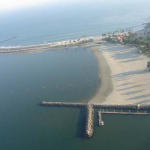Analysis underway for Inner Cabrillo Beach health risk modeling study

A SCCWRP-facilitated advisory committee is reviewing water-quality sampling data collected from Inner Cabrillo Beach to determine whether high fecal indicator levels at the Los Angeles County beach are indicative of a health threat to beachgoers who enter the water.
The committee, which began its review in November, is using data from the beach sampling effort to decide if and how to move forward with using a health risk model known as Quantitative Microbial Risk Assessment (QMRA) to quantify the risk of gastrointestinal illness for Inner Cabrillo beachgoers.
Inner Cabrillo is a popular swimming spot in the Los Angeles Harbor area where fecal indicator bacteria concentrations frequently exceed water-quality guidelines. More than $20 million has been spent to reduce contamination levels, but bacterial concentrations continue to exceed objectives; the beach has a bacterial TMDL (total maximum daily load).
The project’s advisory committee is reviewing data on fecal indicator bacterial levels, as well as genetically based fecal markers specific to humans and birds. Human sources of contamination are much more likely to contain the pathogens that make people sick.
QMRA is designed for use in places where the contamination sources are not human, according to 2012 guidelines issued by the U.S. Environmental Protection Agency.
More news related to: Microbial Water Quality